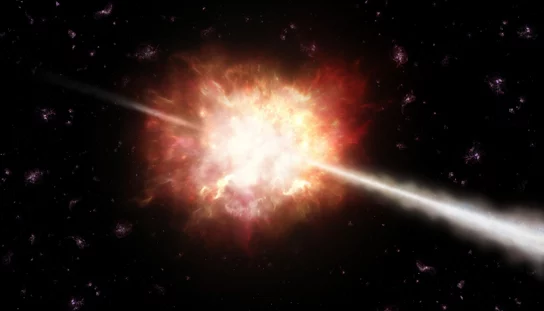Gamma Ray Bursts (GRBs) are mysterious astronomical phenomena that carry valuable information about the early universe. First discovered in the 1960s, GRBs are extremely powerful explosions emitting gamma radiation with immense energy. They last only a few seconds, yet their light can illuminate the entire observable universe, spanning both space and time. These explosions are not only fascinating astronomical events but also keys to uncovering the chemical composition and formation of the universe from the early days after the Big Bang.
According to NASA, GRBs can provide insights into the first stars in the universe, stars born just a few hundred million years after the Big Bang. “These bursts shine across the observable universe, not only in space but also in time, as some of these explosions happened billions of years ago,” NASA experts stated. These first stars, although short-lived, were enormous and extremely bright. They are known as “superstars,” and their collapse into black holes generates GRB explosions.

At a NASA conference in Munich, scientists discussed how to use GRBs as “cosmic flashlights” to help determine the chemical composition of the early universe. According to Volker Bromm, an astronomer at the University of Texas, GRBs can help researchers better understand the first chemical elements that appeared in the universe. “GRBs may carry information about the chemical composition of the first stars in the universe,” he shared. These stars contained basic elements such as hydrogen and helium, and studying them could help us understand how more complex elements, like carbon and oxygen, were formed in later generations of stars.
“GRBs are not only special astronomical events but also open the door for us to explore the mysteries of the early universe, allowing us to understand the evolution of elements in space and the formation of celestial bodies.” Volker Bromm, Astronomer at the University of Texas
Although GRBs are unpredictable events, they are incredibly bright and easily observable. When a GRB occurs, its intense light can easily outshine the light from distant galaxies. These explosions can be analyzed through spectroscopy, breaking them down into different wavelengths to study the chemical “traces” they carry. These wavelengths allow scientists to identify the chemical elements that absorb light during the explosion, providing insights into the chemical makeup of the early universe.
An important factor in studying GRBs is the ability to combine data from both space-based telescopes and ground-based telescopes. Space telescopes such as NASA’s Fermi and Swift play a key role in detecting and tracking GRB explosions. However, because these explosions are brief and can occur in distant locations, ground-based telescopes must collaborate with space telescopes to gather complete information. This data helps astronomers not only analyze explosions from the first stars but also from galaxies in different epochs, opening up opportunities to study the evolution of the universe over the past 13 billion years.
“GRBs can provide us with crucial clues about how the basic elements were created in the universe, and how they combined to form celestial bodies and planets,” NASA experts shared. These studies not only help us understand the early universe but also contribute to expanding humanity’s knowledge of how the universe evolved through successive generations of stars, thus unraveling the mysteries of the origins of elements in space.


HPX24h > Space > Gamma Ray Bursts and the Key to the Chemical Composition of the Early Universe
Top Reads from This Category
Space
Exploring Saturn’s Moon Phoebe: Planet-Like Features and Characteristics
Space
Could Our Universe Have Collided With Another Universe Billions of Years Ago?
Space
The Smallest Star System with Three Exoplanets Found by NASA’s Kepler
Space
Tidal Heating: A New Challenge for Extraterrestrial Life
Space
Exploring Gravitational Forces and the Evolution of the Universe
Space
Habitable Exoplanets: Exploring Distant Worlds
Space
3D Lunar Map: A New Gateway to Understanding the Universe
Discover New Topics
Science
New Hope for the Blind: A Breakthrough in Retinal Implant Technology
Parenting Tips
How to Talk to Your Child About Smoking Issues
Science
The Mystery of the Brain Network that Regulates Human Attention Has Been Unveiled
Animals
Rats Help Each Other: When Compassion Emerges from Small Creatures
Science
Regrowing Adult Teeth in Just 9 Weeks: Science Turns the Impossible into Reality
Health
Step-by-Step Guide to Safely Relieving Bloating in Children
Fitness
Exercise – The ‘Miracle Cure’ to Awaken Overall Health
Health
What Is Epigastric Pain and What Causes It
Health
The Mystery of Newborn Weight: How Does It Progress Each Month?
Science
The Science Behind CRISPR: Can Animal Genetic Modification Lead Us to a Better Future?
Animals
Ravens Use Gestures to Find Mates: A New Discovery About Their Intelligence
Animals
Decoding Whale Songs: When the Community Joins to Uncover the Ocean’s Mysteries
Healthy Eating
How to Create a Diet that Reduces Disease Risk While Still Being Delicious?